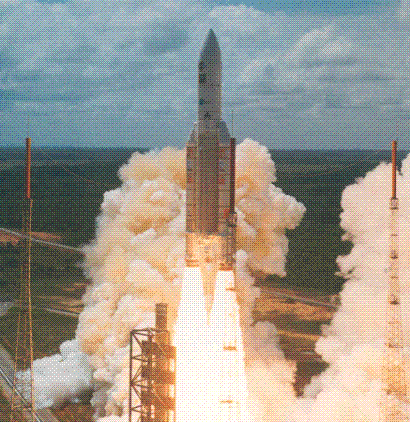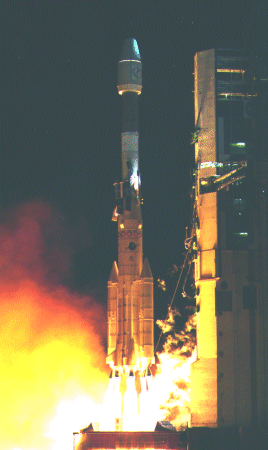Tim Furniss/LONDON

European commercial space launcher group Arianespace is facing increasing challenges to its market dominance as the USA prepares to launch its new fleet of Evolved Expendable Launch Vehicles (EELVs).
The first flights of the versatile Boeing Delta IV and Lockheed Martin Atlas V-based EELVs are two years away, but the companies have 31 firm commitments for launches from 2003-10, according to the US Air Force.
The Heavy versions of the Delta and the Atlas V, capable of carrying payloads of up to about 14,000kg to geostationary transfer orbit (GTO), are expected to halve the commercial launch price in an already volatile market. The Delta IV Heavy version accounts for 60% of launch commitments, or $2 billion in orders.
Arianespace contends that guaranteed US Government business for the yet to be launched boosters has given the EELV a rapid entry into the civil commercial launcher market where it will compete with its own Ariane 5, which is to make its first commercial flight in April.
Market revolution ahead
Arianespace officials recognise that the company must not only position itself to compete in the price war, but also offer an active fleet to meet increasingly different demands.
Such diversification is unavoidable as the commercial market is about to "-experience a revolution", says Pierre Gojat, Arianespace regional director of sales and marketing.
The traditional commercial launch destination today is geostationary orbit (GEO), where about 180 commercial telecommunications satellites now operate. A total of 80% of thecurrent launch business is in GEO telecommunications satellites, with 60% of that in craft providing entertainment services. To date, Arianespace has captured 56% of the overall GEO communications market.
But new launches to medium earth orbit (MEO) are being introduced for global positioning system satellites and mobile communications spacecraft.
Even more likely to explode, company officials predict, could be the market in launches to low earth orbit (LEO) for satelliteconstellations offering global paging, mobile telecommunications and broadband multi-media services. The LEO market represents about 10% of the total launch business today: by 2005, that figure could reach 50%.
The new market will require the flexible and diverse deployment capability of a succession of launches - the large ones first, to support the establishment of new operations with many satellites on one launch, then smaller ones, to maintain the required number of operational satellites in orbit.
Supply to exceed demand
Sustaining a 15-20% share of this market is critical to Arianespace's continued leadership of the commercial launch business in light of increasing competition from US launchers and new international small launchers, sources say.
Arianespace officials estimate that the satellite launch capacity last year of about 50 lift-offs will triple in 2008, with most of the additions coming from LEO satellite constellations.
Industry estimates indicate that, to 2005, 25-30 satellites weighing 4,000-6,000kg will require GEO launches. Many more satellites, weighing up to 11,000kg, will require dedicated, rather than shared, launches, such as those ferried into space today by Ariane 4 launches.
In 2005, there will be a diversified market for all types of launchers, from LEO to GEO, for all masses of payloads. Arianespace officials predict that competition will be fierce. "Supply will exceed demand and that means a fall in launch prices, " says Jerome Paolini, the company's new vice-president for international affairs and corporate communications.
For example, in 1995, it cost $30,000 to launch 1kg into GEO. That price is expected to fall to $12,000 in 2005.
Arianespace plans to compete vigorously for business, offering "any mass to any orbit" and a "first in, first out" policy, to ensure that satellite manufacturing delays do not hold up other launches. About 10 such delays occurred last year, say industry sources. "If a satellite is delivered to the launch site late for a scheduled launch, it will be moved down the queue and the next arrival will get the ride," says Gojat. Arianespace offers a guaranteed ride and a free relaunch if there is a booster failure.
The goal will be to make 8-10 Ariane 5 launches a year by 2005, with two or more LEO constellation flights, meeting GTO, MEO and LEO goals and also fulfilling government heavy science, planetary and International Space Station support obligations.
Meeting these goals will depend upon doubling the Ariane 5's 6,000kg payload performance for a dual satellite launch to GTO - the staging post to GEO - by 2005 and by modifications to enable it to meet MEO and LEO demands. Manufacturing costs will have to be reduced by 40% by 2003 and by a further 10-15% within the following two years, according to Paolini.
Already fully funded Ariane 5 improvements include a new Vulcain MkII first stage cryogenic engine, which will raise dual satellite GTO performance to 7,500kg by 2002.
Partially funded upgrades have been introduced to meet the new ballistics requirements, re-ignition and multiple separation of satellite constellations, and a direct-to-GEO launch capability. These upgrades include the development of a re-ignitable liquid oxygen/liquid hydrogen upper stage engine, ESC A, to raise GTO performance to 9,000kg in 2003, and a versatile restartable version of the Ariane 5 EPS upper stage engine for LEO constellation work.
A more powerful ESC B upper stage engine will be introduced in 2005, enabling 11,000kg to be placed in GTO and matching the Delta IV Heavy booster's dual-launch capacity. In some cases, the Ariane 5 ESC engine will allow direct insertion into GEO. The Delta IV's maximum single satellite capability to GTO is 14,000kg.
Full funding for these later, vital, improvements to the Ariane 5 could be given the green light at the next European Space Agency Council meeting in Brussels in May. It is understood that Arianespace's survival depends on such funding, amounting to an estimated$1.32 billion.
In anticipation of the go-ahead for the ESC stage development, improvements are already being made at the ELA 3 launch pad at Kourou, Guiana, to accommodate the cryogenic stage. The construction will stop Ariane 5 launches for three to four months in the middle of this year.
Three Ariane 5 commercial launches are planned in 1999, starting in April with the first Arianespace commercial Ariane 5 flight, carrying the Eutelsat W4 and Telekom 1 communications satellites.
The Ariane 4 will continue to be flown until 2003, according to current plans. It flew 11 missions in 1998, and is scheduled for nine this year, but its launch rate is expected to be reduced gradually, so that, by 2003, it will have only two missions left. Some of its remaining launches are likely to be of satellite constellations, such as the flight of five Globalstars planned for September. Conversely, the Ariane 5 will fly six to seven launches a year from 2000-4, when its launch rate is expected to go up to eight a year.

Introducing the soyuz
Smaller boosters will be needed for replacement satellite and small constellation launches. Arianespace has addressed this market by introducing the Russian Soyuz launcher, operated by Franco-Russian consortium Starsem, comprising Russia's Samara, as well as Aerospatiale and Arianespace. The Soyuz began a series of six launches last month. That will put into orbit a total of 24 Globalstars.
Expanding its mission range, customer service and launch access, Arianespace will eventually fly the Starsem Soyuz booster from Kourou, mainly for constellation launches. It is expected also to offer the new European Vega booster for LEO launches.
The company expects to continue to form commercial partnerships with complementary launcher organisations - such as Antrix in India and Rocket Systems in Japan - to allow launch service proposals that are compatible with any relevant launcher to allow service flexibility.
Source: Flight International























